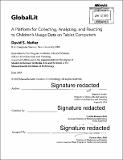| dc.contributor.advisor | Cynthia Breazeal. | en_US |
| dc.contributor.author | Nuñez, David S. (David Scott) | en_US |
| dc.contributor.other | Massachusetts Institute of Technology. Department of Architecture. Program in Media Arts and Sciences. | en_US |
| dc.date.accessioned | 2015-09-17T19:00:18Z | |
| dc.date.available | 2015-09-17T19:00:18Z | |
| dc.date.copyright | 2015 | en_US |
| dc.date.issued | 2015 | en_US |
| dc.identifier.uri | http://hdl.handle.net/1721.1/98622 | |
| dc.description | Thesis: S.M., Massachusetts Institute of Technology, School of Architecture and Planning, Program in Media Arts and Sciences, 2015. | en_US |
| dc.description | Cataloged from PDF version of thesis. | en_US |
| dc.description | Includes bibliographical references (pages 103-109). | en_US |
| dc.description.abstract | Mobile devices, like tablet computers, are potentially potent tools for delivering language learning to children otherwise unreachable at any reasonable scale in a variety of home situations. The ubiquity and distribution of these devices make them ideal research tools, as well, and provide an opportunity to collect field data from children using tablets and ultimately about child-driven learning. This thesis describes a system, GlobalLit, through which researchers and educators can collect, analyze and react to data from various deployments around the world. The system enables geo-shifted data collection, normalized among heterogeneous deployment configurations around the world. Time-Shifted analysis allows us to understand the life-cycle of tablet use and exploration models in short-term engagements alongside long-term multi-year studies. Probes can be examined at a variety of scales (ex. Regions, Deployments, Tablet Groups (Conditions), Individuals). The system supports a Live mode in which data streams from the tablet in real time. The thesis presents background on field research, data collection frameworks, and the current state of tablets and applications applied to children's literacy and education. The thesis explains the design and architecture of the GlobalLit system, including the software infrastructure used to enable the platform. Two case studies illustrate example applications for the platform demonstrating observations made possible by GlobalLit on data sets from deployments around the world and showing how the GlobalLit system can be used to collect high fidelity data in a live, laboratory study. Through the presentation and discussion of the system and potential applications, this thesis attempts to show the potential value of systems like this for research and intervention for child literacy. | en_US |
| dc.description.statementofresponsibility | by David S. Nuñez. | en_US |
| dc.format.extent | 123 pages | en_US |
| dc.language.iso | eng | en_US |
| dc.publisher | Massachusetts Institute of Technology | en_US |
| dc.rights | M.I.T. theses are protected by copyright. They may be viewed from this source for any purpose, but reproduction or distribution in any format is prohibited without written permission. See provided URL for inquiries about permission. | en_US |
| dc.rights.uri | http://dspace.mit.edu/handle/1721.1/7582 | en_US |
| dc.subject | Architecture. Program in Media Arts and Sciences. | en_US |
| dc.title | GlobalLit : a platform for collecting, analyzing, and reacting to children's usage data on tablet computers | en_US |
| dc.title.alternative | Platform for collecting, analyzing, and reacting to children's usage data on tablet computers | en_US |
| dc.type | Thesis | en_US |
| dc.description.degree | S.M. | en_US |
| dc.contributor.department | Program in Media Arts and Sciences (Massachusetts Institute of Technology) | |
| dc.identifier.oclc | 920474629 | en_US |
